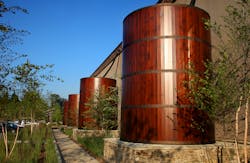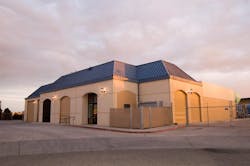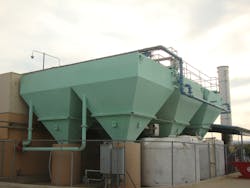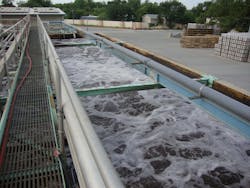On-site wastewater treatment at Sierra Nevada Brewing Company
At Sierra Nevada Brewing Company, sustainability is both a cultural and operational philosophy. Since its founding in 1980, the award-winning brewer of beers such as its namesake Pale Ale has committed to limiting environmental impacts while brewing the high-quality beverages it has become known for. Both at its original location in Chico, Calif., and at a second location in Mills River, N.C., the brewer’s efforts include solar panels installed on the roofs of buildings, electric vehicle charging stations, CO2 capture and thermal energy reuse, as well as sustainable farming practices and composting programs at its restaurants. At Mills River, a stormwater capture and reuse program, consisting of 2.58 acres of permeable pavers in its parking lots and 12 rainwater cisterns, diverts excess stormwater.
But Sierra Nevada’s most significant conservation program may be its on-site water treatment plant, which pretreats the brewer’s process water and wastewater effluent, thus improving the quality of the water it sends to municipal treatment plants.
“Our brewery started out of a garage. And then in the mid ’80s, we moved into our current facility, which was at the time much smaller than we are now. And since 1986, we’ve had to be very proactive and build a good relationship with the wastewater utility to make sure that we can continue to operate as we have grown,” Brandon Smith, P.E., engineering manager at Sierra Nevada’s Chico facility said.
“As you can imagine, in a town of less than 90,000 people, they could handle whatever we threw at them [in the early days]. But as we’ve grown over the years — we [currently] have the capacity of almost a million barrels a year in Chico — there is no way a waste treatment plant built for a town of 90,000 people can handle what we could potentially throw at them.”
Smith said without on-site wastewater treatment, the brewery would be subject to surcharges from the local utility and potential EPA fines for exceeding maximum discharge limits. The system has gown alongside the brewery’s; as capacity and treatment needs have changed
The effluent is pumped out the top of the tank; biogas is piped to a biogas clean-up skid. An aerobic digester, using a fine bubble diffuser, aerates the remaining effluent. In the process, it generates biological total suspended solids (TSS) while removing biological oxygen demand (BOD) and chemical oxygen demand (COD). The clarifiers then remove this TSS in addition to any TSS that entered the aeration basins, settling out any solids still remaining. The system removes over 95 percent of the organic load in the water, allowing the city to easily handle the remainder.
“Like any other raw material supplier, we have to make sure that we’re meeting what the [utility] expects. If they can’t handle our waste, we can’t grow. So, that’s really a lot of what it comes down to,” Smith said.
Shortly after realizing success at its Chico facility, Sierra Nevada began construction on a brewery in Mills River, N.C., in 2002, taking lessons learned from the Chico brewery to complete construction on a two-phase anaerobic sequencing batch reactor (ASBR), designed and built by Symbiont. The Mills River location went online in 2014 and is currently producing about 500,000 barrels per year, though the system can handle up to 700,000 barrels annually.
The brewery’s system consists of a 325,000 gallon equalization tank (phase 1), a 1.5 million gallon phase 2 anaerobic bioreactor, and a 155,000 gallon post-aeration tank. The process reduces the volume of solids disposed off site and increases the volume of biogas produced.
“Ideally, the equalization tank is where all hydrolysis, acidogenesis, and acetogenesis occur, while the anaerobic reactor is where our methanogens are making biogas (up to 150,000 cubic feet per day) to feed our microturbines and boilers,” Muston said.
The anaerobic bioreactor, Muston said, is fed for approximately four hours on a 12-hour cycle. For four hours afterward, microbes react in that tank, which is circulating to keep the food in contact with the anaerobic biomass. Afterward, the tank and its contents settle for three hours, and in the final hour of 12, the contents are decanted to the post-aeration tank to be aerated and settled before any remaining solids are removed and returned to the starting point in the process. The final, treated process wastewater is then discharged to the local water utility.
But effective wastewater management in a brewery is not always so easy, Smith said.
“We have kind of the same challenges that a lot of industrial facilities have, where wastewater treatment is at the end of the line and sometimes the production facility upstream doesn’t necessarily appreciate that. So, it is a challenge to make sure on an ongoing basis that everybody remembers that. You have to be very diligent about considering the effects on wastewater downstream when you do anything,” Smith said. IWW
About the Author
Alanna Maya
Editor
Alanna Maya holds a bachelor’s degree in Journalism from San Diego State University and has more than 10 years of experience writing and editing for national publications. She is the editor for WaterWorld and Industrial WaterWorld magazines, overseeing editorial and web content.





